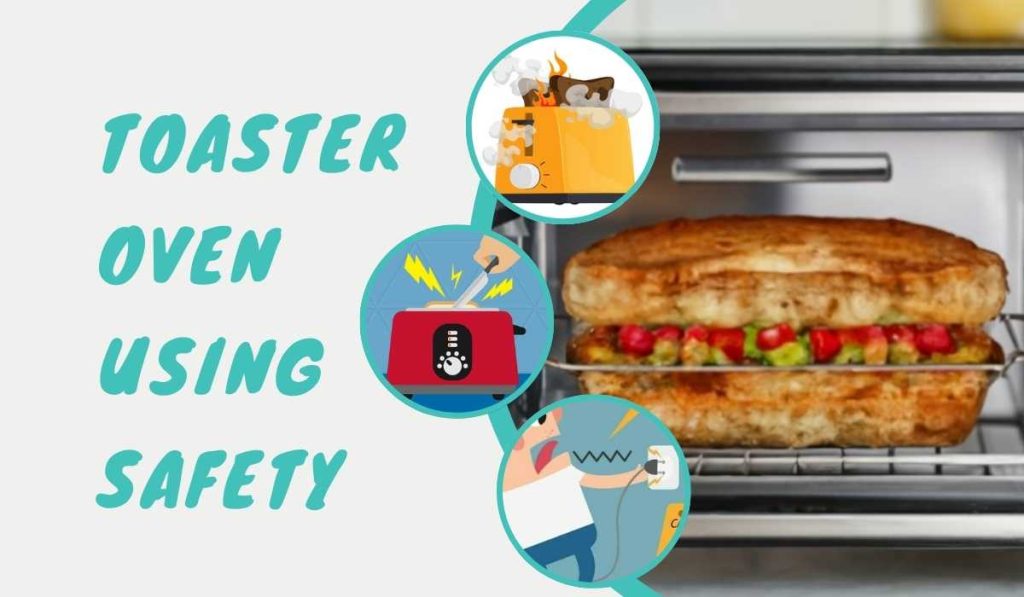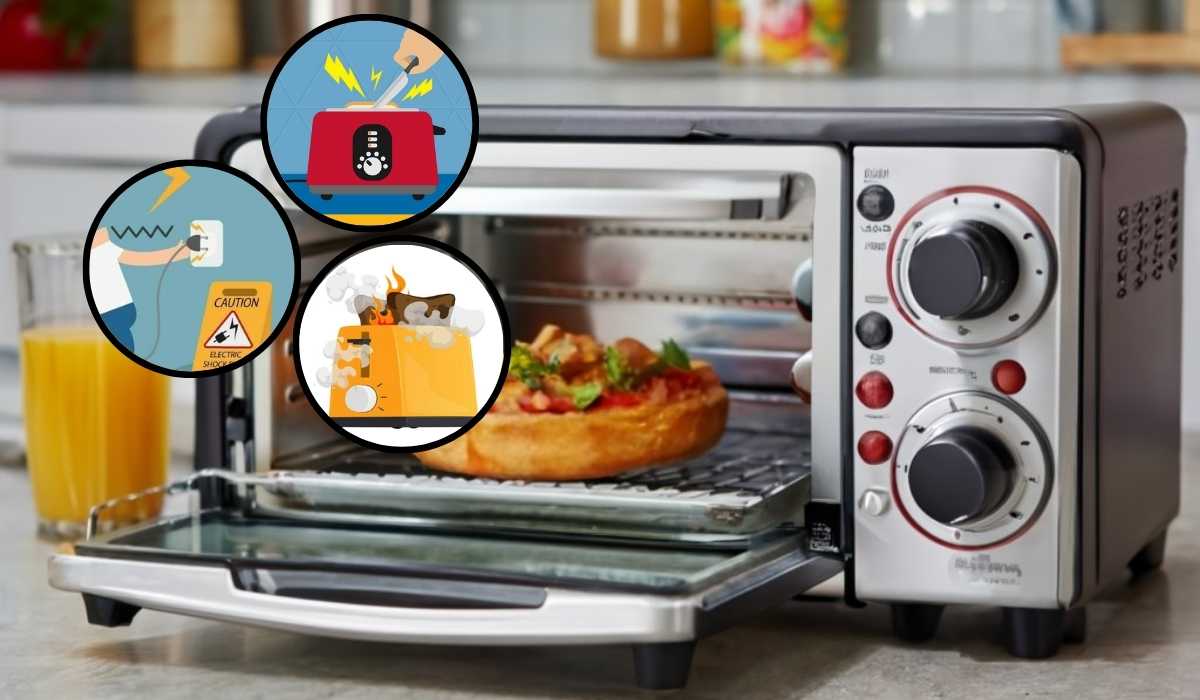Toaster ovens are small and versatile, making them popular in many kitchens. You can use them to toast bread, reheat leftovers, and cook small meals conveniently and with less energy. There are concerns about the safety of the coatings used inside toaster ovens. Are these coatings safe for food contact? Can they release harmful chemicals when heated?
If you’re wondering about the safety of your toaster oven’s interior, you’re not alone. I’ve already seen 16 people asking the same question as you. So here I am, Tammy E. Edison, as an expert in kitchen appliances. In this article, I will talk about the science behind toaster oven coatings. I will also discuss what materials are used inside toaster ovens, potential health risks, and tips. So let’s get started!
First, I will clarify the toaster safety issue.
Are Toaster Oven Interior Safe?
Research says that toaster oven interiors are generally safe for food contact. As you may not know, most toaster ovens are made of non-reactive materials such as stainless steel, aluminized steel, or porcelain, which will not leach harmful chemicals into your food. These materials are great for everyday use. They last a long time and are easy to clean.
Below, I will tell you some things about your toaster oven safety that you have to keep in mind.
Choose a non-stick coating carefully
Some toaster ovens have non-stick coatings made from PTFE or PFOA. These chemicals can be harmful if they are heated to high temperatures. So, it’s best to avoid toaster ovens with these coatings or only use them at low temperatures. About the non-stick coating safety, we have details in the post; if you need more information, please visit.
Clean your toaster oven regularly
Food residue and grease can build up on the interior of your toaster oven. As a result, it can harbor bacteria and cause unpleasant odors. Wipe down the interior of your toaster oven with a damp cloth after each use, and scrub it with a mild detergent and water once a week. However, we have a post on Deep Cleaning Oven. So, if you need more information about cleaning, please look at this post.
Don’t overheat the toaster oven
The non-stick coating can be harmed by overheating, which can also release toxic compounds. Overheating can cause serious damage to your oven and you, such as:
- Overheating a toaster oven can cause a fire. This is because the oven can get very hot and cause grease, food particles, or other flammable things inside to catch fire.
- Misusing a toaster oven can also lead to safety hazards. For example, using the oven to heat or cook items that are not intended for the oven can cause fires or explosions. Using a damaged oven with cords or plugs can cause an electrical shock.
- Touching a hot toaster oven can cause severe burns. Make sure you wait for the oven to cool completely before handling it.
- Using a toaster oven with damaged cords or plugs can pose an electrical shock hazard. Be sure to inspect the oven regularly for any damage to the cords or plugs.
So, if you need to cook food at a high temperature, use a different cooking method, such as broiling or grilling.
Follow these tips to keep your toaster oven safe for food and working well for years.
Next, I will discuss what materials are used in the toaster oven interiors.
What Materials Are Used in Toaster Oven Interiors?
There are four common types of materials I see used inside a toaster oven, such as:
I found that the most common material inside a toaster oven is stainless steel. It is famous for its durability, corrosion resistance, and non-toxic nature. Its smooth surface is easier to clean, and food won’t stick, making cooking healthier. I even noticed that it doesn’t react with food during cooking, so harmful chemicals are not released.
Another material commonly used in toaster oven interiors is aluminum-coated steel. Aluminum is a reasonably priced and lightweight material. It effectively conducts heat, ensuring even cooking. Its reflective properties enhance heat distribution, promoting even cooking and energy efficiency. The aluminum coating provides additional protection against corrosion and improves the oven’s durability.
I noticed that in recent years, non-stick coatings have gained popularity due to their ease of cleaning and food-release properties. However, certain non-stick coatings contain polytetrafluoroethylene (PTFE), also known as Teflon. When heated to high temperatures, PTFE can decompose, releasing harmful fumes. To stay safe, I suggest you choose toaster ovens with non-stick coatings that are PFOA-free and certified for high heat.
Many people like enamel coatings for toaster oven interiors. They are bright colors and last long without getting chipped or scratched. They also provide a smooth surface that is easy to clean and prevents food from sticking. However, there have been worries over the security of enamel coatings, particularly in older models.
Hopefully, I can give you an idea of what materials are used in the test oven.
After that, I will tell you what materials are safe.
What Materials Are Toaster Oven Safe?

Apart from the four ingredients above, I found four more ingredients that are toaster oven safe.
Cast Iron: Heavy-duty cast iron is resistant to warping and cracking, even at high temperatures. Moreover, because it is non-reactive, dangerous substances won’t seep into your meals. But to keep it from rusting and to keep its non-stick qualities, cast iron needs to be properly seasoned.
Ceramic: Ceramic is a material that can withstand high temperatures and is safe for food. It is also relatively durable. But, handling ceramic cookware carefully is essential to avoid chipping or cracking.
Glass: Glass is another non-reactive and heat-resistant material suitable for toaster oven use. It is also easy to clean and maintains its appearance over time. However, like ceramic, glass requires careful handling to prevent breakage.
Silicone bakeware: Silicone bakeware is growing in popularity because it is flexible, non-stick, and can handle heat. It is safe to use in toaster ovens and can withstand temperatures up to 500°F (260°C).
Then, you will know what makes the toaster oven toxic.
What makes toasters toxic?
About the Toaster Ovens Toxic,” this post will provide you with more details. However, some toasters are dangerous because they have non-stick coatings made of PFAS, also known as “forever chemicals.” These chemicals can cause health problems like cancer, thyroid disease, and reproductive issues.
PFAS coatings are often used on toaster interiors to prevent food from sticking. But if you heat these coatings, they can break down and release PFAS chemicals into the air and food.
The Environmental Working Group (EWG) did a study. They found PFAS chemicals in 29 out of 30 toasters. The study discovered that using a toaster for a longer time caused more PFAS to be released.
How Do You Use Inside Of The Toaster Oven Properly Without Risk?
To properly use the toaster oven interior, follow the steps below:
Preheat Safely: Always preheat the toaster oven according to the manufacturer’s instructions. To prevent uneven heating and potential hazards, don’t put too much in the oven..
Use Proper Cookware: Use only cookware that is designated safe for toaster ovens. Avoid using materials that can catch fire, and never use metal utensils that may cause damage to the interior.
Keep it Clean: Maintain a regular cleaning schedule for the toaster oven to avoid food particles, grease, or debris accumulation. Clean the crumb tray, racks, and interior surfaces as recommended in the manual. A clean oven reduces the risk of fires.
Clean the toaster oven: Regularly clean the toaster oven, including the crumb tray, racks, and interior surfaces, following the manual’s cleaning instructions. A clean oven reduces the risk of fires caused by accumulated debris.
Cool Down Properly: Make sure the toaster oven is completely cool before you clean it or touch the inside. This reduces the risk of burns and ensures safe handling.
Place in a Well-Ventilated Area: Use the toaster oven in a place with good airflow to avoid breathing in any smoke while cooking.
Keep Away from Flammable Items: Keep the toasty oven away from flammable objects like paper towels and drapes.
To use your toaster oven safely and avoid accidents, follow these guidelines.
Conclusion
As a user, I can say that toaster ovens are generally safe inside when used and maintained properly. But, you should be cautious of potential dangers, like burns from hot surfaces and electrical shocks from damaged cords or plugs. To reduce these dangers, always follow the instructions for using and cleaning the toaster oven. Never leave it unattended while it’s on.
I hope this post has been very helpful for you. But if you have any valuable opinions or suggestions on this matter, you can let our team and me know. Thank you for staying with us.

Tammy E. Edison is a distinguished specialist in the world of kitchen appliances, and she is proud to be a part of the dynamic team at kitchenusers.com. With a background in engineering and a passion for culinary innovation, Tammy E. Edison has established herself as a go-to expert for all things related to kitchen appliances technology.


